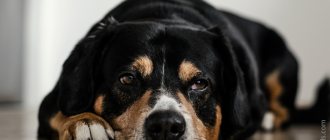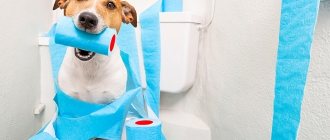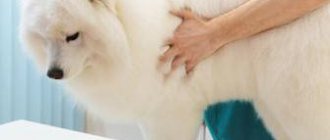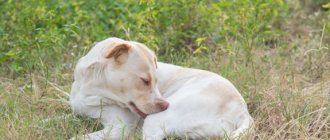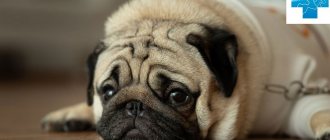If you notice bright orange color in your pet's stool, we advise you to take it very seriously. Find out why in this article. All information was compiled by a practicing veterinarian who has encountered this problem in dogs more than once. Find out how to help your dog and what absolutely should not be done if you have diarrhea.
Changes in the color and consistency of feces in dogs are an important symptom of many diseases of the gastrointestinal tract .
An experienced doctor, and even a breeder, can immediately suspect a number of specific diseases based on these characteristics. Tests and instrumental diagnostic methods will help specify the diagnosis and prescribe treatment.
Watch the video: VETERINARIAN TELLS – How a dog can cope with diarrhea
The dog has orange stool: The mechanism of formation of feces in the intestines
The dog's gastrointestinal tract consists of the mouth, esophagus, stomach, duodenum, small intestine, colon and rectum.
This is a long tube with many sections, along which grinding, splitting, absorption of nutrients from food, and the formation of feces from undigested residues occur.
When food enters the duodenum from the stomach, it is saturated with digestive juices of the pancreas and bile produced by the liver, which break down proteins and fats into easily digestible amino acids glycerol and fatty acids.
Read another useful article about our four-legged friends - Why does a dog have diarrhea with water?
All this is absorbed in the small intestine, and feces are formed from excess indigestible residues moistened with digestive juices.
Water is absorbed in the large intestine, so normal stool comes out with a relatively dense structure and dark brown color.
If the stool becomes unformed, mushy, or even liquid, diarrhea occurs. The color of feces largely depends on the food consumed by the animal.
But a bright orange color almost always signals dysfunction of the pancreas and liver.
What is the poop silent about?
For us, everything is simple - the more times we walk, the more times we go to the toilet. Usually 2-3 times a day. For a walk - once, he can rarely go again and the second outing will be a little worse decorated - the dog seems to be cleaning himself. The color of the output and its consistency directly depend on the food received. When we fed dry food, it was formed and most often the same color, but there was a lot of it and it was smelly. On the contrary, with natural products the output is a little softer, the color palette is more varied, but much smaller and there is no pronounced unpleasant odor.
A good solution is considered to be a small formed poop, without a pronounced strong putrefactive odor, uniform glossy brown color, but without a greasy sheen, without inclusions of undigested food (with the exception of fragments of undigested plant fiber - grass, vegetables, etc.), without mucus and greasy sheen, there should be no traces of blood, black caked feces, traces of helminthic infestation or mucus, green and stringy thread-like discharge, foam and pronounced yellowness, an orange tint of “turmeric” color, or, conversely, complete discoloration of feces.
If the dog walks in a pureed manner and is yellow in color, this means problems with the liver and pancreas, you need to remove fatty foods and stick to a more dietary diet. If recurring watery diarrhea is an acute infection or poisoning, you can try giving a sorbent, smecta, enterofuril in suspension, or brewing chamomile; if it doesn’t go away within one day, see a doctor.
If a dog constantly has poorly formed stools with undigested fragments, a shade of green, this means an incorrectly selected diet, low digestibility, the presence of plant fiber, an excess of cereals in the diet and most likely a chronic gastrointestinal disease[1]
– gastritis, enterocolitis. Feces with a strong greasy sheen, accompanied by softened sandy and yellow masses, indicate a chronic liver or pancreatic disease - cholecystitis or pancreatitis.
Soft, turmeric-colored stools accompanied by elevated temperature may indicate piroplasmosis, an already advanced stage + blood in the urine.
If the dog walks in a pureed manner and when defecating nearby, there is a distinct smell of fish and at the same time the dog often rides on its butt, spins, and tries to lick the anus - this is most likely a blockage of the paraanal glands (chronic diarrhea leads to this disease). If the dog strains, cannot walk, whines - this may be a sign of attachment to the bones, a foreign body, or, less often, a neoplasm; If this happens frequently, you can’t wait – see a doctor. Regular constipation, when the dog walks with visible effort, “stuck” feces that require help, indicates a lack of plant fiber or coarse fibers, this also happens when overeating grass or if the dog has swallowed, for example, threads or a sock - never pull them out of it case it is impossible!
If the stool resembles a foul-smelling plasticine mass with pronounced putrefactive notes, this could be dysbacteriosis at best, or an acute infection at worst, even viral enteritis or even plague, you need to see a doctor. The presence of mucus indicates a helminthic infestation (plus the smell of rancid oil from the mouth, the iris turns blue, rolls on the butt, the stomach is distended) or also an infection/acute disease - enteritis, enterocolitis.
Otherwise, everything will depend on food.
A good poop should be small, well-formed, without a greasy sheen, glossy brown, without blood, mucus, and without a strong putrid odor. The most dangerous thing is black feces and blood - these are traces of internal bleeding. But black feces come from hematogen and vitamins with iron, and red from beets.
If a dog eats a lot of bone matter, the feces will be light, small and crumbly, with fragments of bone chips, sometimes white - this is the norm. When switching from drying to natural, there may be slight softening and stool of different colors, this is normal. On dry food, stool stabilizers and fixatives make the poop formed; on natural food, the animal walks on its own and the stool will directly depend on the correctly selected diet. As you feed, so does he go to the toilet. The presence of undigested pieces of vegetables is the norm. In general, a dog walks 1-2-3 times a day and these are all variations of the norm; the second poop during a walk will be a little thinner, this is correct. If the dog was brushed with grass, this will be reflected in the output.
If your dog eats grass like a cow, consult a doctor. Many foods and medications affect the output: for example, taking choleretic drugs causes relaxation, and sorbents make the stool denser and darker. We walk as in photo 2, if there is a lot of animal fat in the diet - then as in photo 3. On plant foods - as in photo 4. On a diet with a high proportion of bone component - no photo; We walked on BARF like wolves - a small white-gray turd, fell with the sound of a stone and crumbled into dust, without any smell at all. On a diet with cereals, the yield is greater, darker, with a more pronounced odor. On a diet with a lot of vegetables, it is pureed with a sour smell and pieces of undigested food. On a diet with a high proportion of fermented milk products, it is slightly less well-formed, odorless or slightly sour. The biggest and smelliest outlet was dry food, the worst was the Akana and Grandorf brands, we walked around them like a horse, it stank at the other end of the park. In natural poop, poop is different in consistency and color - it clearly depends on the type of food and may vary slightly from day to day, but much less than in dry poop and does not smell as stinky.
This is what E. Tipikina writes in her famous article “What the poop is silent about”:
The “first violins” of the small intestine are the pancreas and liver. They provide it with the necessary secretions and enzymes. The pancreas produces a basic secretion containing enzymes necessary for the absorption of protein and carbohydrates. With an incorrect ratio and frequent changes of food products, the development of chronic sluggish pancreatitis is possible. Indirect symptoms of this disease may be frequent diarrhea, in which the dog's stool usually has a yellowish-brown color with a sharp sour odor.
Poop is not a fart!
Everything in poop is important - the consistency, the color, and, excuse me, the smell. These are the “three pillars” that give an idea of the “final product”. Ideally, a dog's stool is the color of liver pate, or in other words, a rich brown color. The color variations of this “pate” have a scientific basis and are determined by the color of the enzymes and secretions that process this poop even when it is in the gastrointestinal tract.
The liver neutralizes substances harmful to the body. The liver produces bile acids necessary for the breakdown of fat. A large amount of unprocessed fat entering the gastrointestinal tract often causes diarrhea (diarrhea). In liver diseases, stool is colorless. Constipation may alternate with diarrhea. The feces are literally discolored. The poop, like in a black and white movie, is light and not colored. Like cement. Faded gray, “dead”, pale. Just a digression: if, through an oversight, a dog ate tubular bones with a porous internal structure, then its feces may look like a hard, dry, gray compressed substance. Such a poop falls on the asphalt with an audible sound. But such a stool usually happens once. We are talking about liver diseases - hepatitis. And then the discolored feces can have a varied consistency, but will remain discolored for a long time.
The last point of our journey is the large intestine.
Here the body offers an “ecological niche” to typical bacteria, which coexist with the dog’s body on mutually beneficial terms. They obtain food by breaking down some otherwise indigestible substances (for example, fiber), and with the help of their metabolic products (vitamins, fatty acids) they supply the dog with vital substances. The type of fiber affects the speed of movement of intestinal contents. Fiber quickly ferments and diarrhea occurs. Slowly - constipation occurs. Moderately (as expected) fermentable fiber provides optimal fecal consistency.
Well, we’ve reached the main thing – the information substrate – the correct poop.
A healthy body... produces healthy poop. It is well-formed, without visible inclusions, does not stain the wool, is smooth, with a wet sheen, dark brown in color, moderate odor and small volume. Defecation 1 – 3 times a day.
Marina*, point by point: a wall newspaper and an apartment-museum can be well designed. Describe, as far as possible, the correct design of the poop. Her appearance?
A type of sausage with a diameter equal throughout its entire length, corresponding to the diameter of the dog’s anus. A particularly excellent “sausage”, landing vertically, retains its shape for some time.
If “chopped” dense circles of this very “sausage” fall out of the dog individually, then most likely there is not enough fiber in the diet. A moist sheen indicates proper fermentation of the fiber.
There are the following deviations from the scientifically based norm:
A. A shaped poop, but on top - the final, so to speak, touch - liquid porridge. Dysbacteriosis. Possibly an infectious disease.
B. Formed poop, but with mucus. Sometimes mucus with blood. It happens with diseases of the large intestine and with helminthic infestation, as well as when feeding meat products with a large amount of connective tissue (veins, etc.).
B. Pasty, brown to yellow in color with visible inclusions of undigested food with a sour odor. Defecation 2-5 times a day. Categorically wrong diet.
D. Crumbly, dry, hard poop with a whitish coating 1 time per day - exclude bones, cartilage and stringy meat from the diet!
The sight of these options should make you wary and consult a nutritionist.
“Something needs to be changed at the conservatory!” - as Zhvanetsky said
Your dog has orange diarrhea: Symptoms
With pancreatitis , in addition to diarrhea and the characteristic color of stool, there will be vomiting , lack of appetite, fever, and pain.
The dog will be restless, will not allow you to palpate the abdominal cavity, and will whine. Vomiting can be painful and uncontrollable.
Hepatitis is characterized by:
- lethargy of the animal,
- lack of appetite,
- change in the color of stool to orange and light yellow,
- diarrhea - the urine becomes dark,
- yellowness of the mucous membranes of the oral cavity, eyes appears,
- the liver is enlarged and painful on palpation,
- body temperature rises (with acute hepatitis); in chronic cases, the animal’s body temperature remains within normal limits.
Piroplasmosis is characterized by:
- lethargy,
- refusal to feed,
- increased body temperature,
- darkening of urine
- change in stool color to orange,
- yellowness of the sclera of the eye and oral mucosa,
- weakness of the hind limbs,
- vomiting.
If the animal has suffered from infectious enteritis or salmonellosis, then a change in the color of the stool to orange indicates the development of complications in the pancreas and liver.
IMPORTANT! If you notice a persistent change in the color and consistency of stool , especially if there are other symptoms (fever, vomiting, lethargy, jaundice), you must immediately contact a veterinary clinic. Delay and treatment with home remedies can be fatal.
What you need to know about dog poop
What kind of stool should a dog have? Normally, dog feces should have a dense consistency. Moreover, its color can be light or dark brown.
Yellow stool may be a symptom of a disease
Important! Any changes in color and consistency indicate some kind of violation. It can be temporary or chronic. To determine the causes of yellow stool in a dog, you should consult a doctor.
Orange diarrhea in a dog in Moscow
In Moscow you can contact veterinary clinics:
- "Your Doctor" network
- "White Fang",
- as well as at the Innovative Veterinary Center of the Moscow Veterinary Academy (IVC MBA).
Links to good animal hospitals:
- veterinary-help.ru
- zooadrenalin.ru
- zoostatus.ru
- svoydoctor.ru
- dobruy-doctor.ru
- vetcentr.ru
- dobrovet.ru
- veterinarianmoscow.rf
Click on the picture to enlarge
What could be the reason?
Such symptoms are provoked by various reasons. But even if the dog simply ate too much the day before or was seen near garbage cans, you should not ignore the illness and let it take its course. A veterinarian can determine the exact cause of a dog’s yellow, loose stool after an examination.
This condition is often caused by the following reasons:
- unbalanced diet;
- progression of an infectious disease;
- helminthic infestation;
- intoxication with toxic substances, chemicals;
- food poisoning;
- the presence of gastrointestinal diseases;
- oncological diseases;
- allergic reaction;
- stress;
- deficiency of microelements, vitamins;
- improper digestion of food;
- impaired metabolism;
- entry of foreign objects into the gastrointestinal tract;
- a sharp change in diet and diet.
Orange diarrhea in a dog is a signal of the presence of jaundice. Bright yellow diarrhea is provoked by pathologies of the pancreas, pancreatitis, cirrhosis.
Yellow diarrhea with mucus in a dog indicates the presence of parasites in the body: cestodes, liver flukes, nematodes.
Prolonged stool disorder is often a sign of an existing disease that requires medical intervention and treatment. Ignoring it is fraught with dehydration, damage to the respiratory system, leukopenia, and death.
The dog has orange diarrhea: Diagnosis and recognition of the cause
When contacting the clinic, a veterinary specialist will take the following measures:
- Anamnesis collection.
- Inspection.
- Thermometry.
- General blood and urine analysis.
- Blood chemistry.
- Stool analysis - scatological examination.
- Ultrasound of the abdominal organs.
- Blood test for piroplasmosis (if suspected).
- Rapid tests for canine distemper, parvovirus enteritis.
Watch the video: THE BEST DOCTOR'S ADVICE - Your dog will be healthy!
Traditional methods of treatment
At home, after consulting with a veterinarian, the main treatment can be supplemented with alternative medicine. For a dog with diarrhea, you can give a steep rice decoction, a decoction of chamomile, oak bark, cinquefoil, and St. John's wort.
Healing plants must have astringent, anti-inflammatory, and restorative properties . Healing compositions and tinctures are given to the pet three to five times a day, one tablespoon. The dosage is selected taking into account the age and body weight of the dog.
For severe diarrhea, an infusion of pomegranate peel will help at the initial stage. Pour dry, pre-washed peel with warm boiled water at the rate of 15 g per 300 ml of water. Leave for 35-40 minutes. Give a dog with diarrhea one tablespoon every hour, but no more than two to three days.
Orange stool in a dog: Treatment
Depending on the severity of the disease, treatment can be carried out on an outpatient basis, that is, by the owner of the animal at home with periodic visits to the clinic, or in a hospital - in cases of severe dehydration, uncontrollable vomiting, severe diarrhea, and cardiac dysfunction.
Your veterinarian will prescribe the following:
- A fasting diet lasting at least 24 hours.
- Antispasmodics (No-shpa, Papaverine ).
- For indomitable vomiting, Cerucal is prescribed.
- Infusion therapy to restore water and electrolyte metabolism (Ringer's solutions, Glucose, Poliglyukin).
- If an infectious disease is diagnosed, then antibacterial or antiviral therapy is carried out.
- To normalize the enzymatic function of the pancreas Kontrikal.
- Compliance with a veterinary diet.
Pathological causes of yellow diarrhea in puppies
The appearance of yellow, gray, pink or orange stool can be due to various factors. You can often see mucus or blood in the stool. In such a situation, it is recommended to begin treatment immediately.
Do dogs distinguish colors or not and which ones?
Jaundice is considered a common cause. When it occurs, bilirubin does not pass into other particles and enters the intestinal lumen. As a result, the stool turns yellow or orange and has a watery texture. In addition, the disease is accompanied by damage to the mucous membranes and skin. Dogs experience nausea and vomiting.
The reason for the change in the shade of stool is the following:
- chronic hepatosis;
- cirrhosis of the liver;
- disorders of the liver due to the use of drugs;
- abnormalities in the functioning of the gallbladder;
- tumors in the pancreas;
- inflammation of the pancreas;
- obstruction of the bile ducts.
Note! Sometimes the appearance of problems is caused by helminthiasis. Worms not only affect the liver and intestines, but also poison the pet’s body.
An excess of fatty foods in a dog’s diet is also considered a provoking factor for problems. Most often, pets that receive food from the human table are susceptible to this problem. The cause of diarrhea is sausages and products with vegetable oil.
A putrid odor from feces indicates an infection has entered the body. Provoking factors are plague, salmonellosis, and enteritis. At the same time, the pet experiences a decrease in activity and loss of appetite. In such a situation, you need to immediately start treating the dog.
Important! Of particular danger is the presence of bloody impurities in the stool. They indicate dangerous infectious pathologies and the entry of foreign objects into the intestines.
Toy dog breeds are sensitive to the ingredients of industrial feeds. Thus, a miniature dog may react to low-quality food or the presence of flavors, lipids, or stabilizers in it.
Sometimes the cause of problems is constant stress, allergic reactions, and emotional overload. Diarrhea may be a consequence of high sensitivity to drugs.
The provoking factor may be infection
In rare situations, bowel dysfunction is a result of immunization. It is observed within 2 days after vaccination.
Stool disorders occur due to the constant use of antimicrobial agents. Antibiotics inhibit beneficial intestinal microflora. As a result, the dog develops dysbiosis.
Veterinary diet for inflammation of the pancreas and liver in a dog
A veterinary diet involves feeding the animal in small portions 5-6 times a day. To do this, you can use either natural products, or specialized dietary foods or baby food.
In the first days of the disease, the animal can be given oatmeal, cooked in water, or children's instant porridge.
After this, as the animal’s condition improves, fermented milk products and low-fat baby meat purees can be introduced into the diet.
Then, when the animal recovers, it can be gradually transferred to normal food (but do not give food from the table, even if the dog eats natural food and not feed)
If your dog is accustomed to eating food, then you need to purchase medicinal dietary food in the form of pates from the following companies:
- Royal Canin Gastro Intestinal Moderate Calorie,
- Hill's i/d,
- Eukanuba Intestinal.
Dietary foods consist of easily digestible components, prebiotics.
If an animal develops a chronic form of pancreatitis, then it will have to eat this food for life, but in dry form.
Prohibited foods for feeding dogs with pancreatitis and hepatitis:
- Fatty meat, fish.
- Bakery products.
- Smoked meats, pickles.
- Cheap food (like Pedigree).
If an animal is diagnosed with piroplasmosis, then in addition to the symptomatic treatment described above, the animal is prescribed the antiprotozoal drug Pirostop.
It is administered once or twice and allows you to destroy piroplasms in the animal’s blood.
Click on the picture to enlarge
When a visit to the vet should not be postponed
Yellow feces indicate disturbances in the functioning of the digestive system, so this symptom is the basis for a visit to the doctor. The specialist will conduct a detailed diagnosis and, based on its results, prescribe complex therapy. It often includes anti-inflammatory drugs, antibiotics, and antivirals.
For your information! Antibiotics are selected taking into account the causative agent of the pathology. Usually there is a need to use cephalosporins and sulfonamides.
To avoid dehydration of the body, it is worth administering infusion solutions of glucose, ringer lock, and saline solution. When the main signs of the disorder pass, the animal needs to be provided with a strict diet. The pet should not be fed during the day. At the same time, clean water should be freely available.
If suspicious symptoms appear, you should contact your veterinarian
Often, with such a symptom, enzymes, probiotics, and sorbents are indicated, which help destroy toxins. To stop severe diarrhea, you should give your dog drugs based on loperamide. Smecta, Sorbex, Enterosgel help eliminate the symptoms of intoxication.
If a dog experiences pain, it is given antispasmodics and analgesics. If bloody impurities appear in the stool, hemostatic agents with vitamin K are indicated.
Yellow feces in a dog can be a manifestation of various abnormalities. To make an accurate diagnosis, it is necessary to contact a veterinarian in a timely manner and strictly follow his recommendations.
The dog has yellow diarrhea with mucus: Moscow, choice of clinic
We have selected a list of good veterinary clinics for Muscovites and residents of the capital:
- Medvet . Network of clinics. Branch ave. Vernadsky, 89, bldg. 6. Winner of the Golden Scalpel veterinary award. An appointment with a therapist costs about 1,300 rubles.
- White Fang . Network of clinics. One of the branches is Mitinskaya Street, building 55, building 1. They work around the clock. There is a doctor on call at home, which is important if it is not possible to transport the dog to the doctor. An appointment with a therapist costs about 1,500 rubles, and a gastroenterologist costs 2,800 rubles.
- Zoostatus . Varshavskoe highway, 125, building 1. Works around the clock. An appointment with a therapist costs about 1,500 rubles. There is a specialist gastroenterologist, the cost of which is about 2000 rubles.
- Biocontrol . Kashirskoye sh., 24, building 10. Appointment with a therapist: 1,500 rubles. The clinic provides a pet taxi service, which is undoubtedly very convenient.
- Your doctor . Network of clinics. There are about 120 veterinary specialists on staff, including 12 candidates of veterinary sciences. Appointment with a general specialist costs 900 rubles, and a specialized specialist costs about 1,500 rubles.
- Komondor . Moscow region, Rublevo-Uspenskoe highway, Gorki-2 village, no. 45. In addition to the presence of a gastroenterologist, the clinic has a rehabilitation building with a swimming pool, fitness and massage. Works around the clock.
These clinics follow the principles of evidence-based veterinary medicine in their work and have a large number of highly specialized specialists on staff, which is very convenient. They have all the necessary equipment for timely diagnosis and assistance to your pet.
These clinics also have many positive reviews. The owners note the high professionalism of the specialists and the quick provision of assistance. For example, at Biocontrol an animal can undergo medical examination in just an hour.
Prevention of the condition
To avoid such problems, you need to follow preventive measures. Among the main ones are the following:
use only high-quality feed;- ensure that your diet contains enough foods rich in vitamins and minerals;
- observe the rules of hygiene;
- take a responsible approach to choosing places to walk;
- regularly carry out prevention of helminthic infestation;
- Monitor your pet's condition closely and, if there are any negative changes, immediately seek help from a veterinarian.
Modern methods of treatment
Treatment of diarrhea in dogs is carried out after an accurate diagnosis has been made. Also, in addition to the main therapy aimed at eliminating the causes of the disease, a set of measures is carried out to replenish the supply of moisture in the body, which is lost in large quantities during diarrhea. Anti-inflammatory drugs and probiotics are also prescribed, and an individual diet is developed. During the recovery stages, the dog also receives immunostimulants to help its body recover faster.
In severe cases, when the cause of diarrhea is a foreign body in the intestines or a tumor, surgery is prescribed. It is performed under general anesthesia in the presence of an anesthesiologist, so that the health and life of the four-legged patient is not in danger.
Treatment of diarrhea
Typically, veterinarians advise not to feed your pet for 12 to 24 hours. But at the same time, the animal must have a large amount of water to drink. This is necessary in order to avoid dehydration. Before treating an animal, you should consult a doctor. After all, there are many reasons for the appearance of diarrhea.
Specific treatment requires an accurate diagnosis. At the first stage, the doctor can prescribe treatment that will help quickly eliminate the symptoms, and will definitely prescribe tests in order to identify the true cause of diarrhea. In addition, tests will help against infectious or bacterial diseases. Symptomatic treatment includes one of the following:
- After a half-starvation diet, the animal must be fed with easily digestible food. It can be boiled chicken, beef, which is mixed with low-fat cottage cheese, potatoes or rice. It is recommended to follow a light diet for the next few days. After this, gradually switch to your usual diet.
- Infusion therapy can be used to prevent dehydration.
- If an animal is diagnosed with hemorrhagic gastroenteritis, the mandatory use of antibiotics in treatment.
- To protect the intestines, the doctor prescribes adsorbents and drugs that protect the mucous membrane.
- The doctor may prescribe other medications, for example against helminths. But all medications are prescribed depending on the degree of the disease and the characteristics of the animal’s body.
A large number of dog owners, at the first symptoms, run to the pharmacy and buy drugs that can seriously harm the animal, although they will eliminate the symptoms. Only a doctor can tell you whether it is possible to give it to a dog for diarrhea and what other medications to use.
A popular drug among medications is rehydron. This is a powder that must be diluted with water and given to the dog to drink. The product helps to quickly eliminate diarrhea, has a beneficial effect on the intestinal walls, and can be used for diarrhea with blood. It heals wounds in the intestines well.
Do not use any medications without visiting a veterinarian. Dogs have very sensitive bodies and improper treatment can have lifelong consequences.
Preventive measures
The best treatment for your pet is home care and examination by a professional veterinarian. To ensure your pet’s health is excellent and you don’t have to go to the clinic, just follow a few simple rules:
- follow all doctor's recommendations. If your dog still has diarrhea, it is better to stick to the diet and if there are difficulties in treatment, be sure to consult a doctor;
- Constantly monitor the general condition of the animal. Monitor the amount and condition of stool, whether there is blood or mucus. Watch carefully to see if the dog has an appetite or weakness;
- If you notice diarrhea, it is better to immediately switch to a balanced diet. Do not give the animal spoiled food, monitor the entry of foreign objects into the body;
- be examined by a veterinarian every year and tested for parasites and infections;
- diarrhea is usually easy to cope with and the prognosis is almost always favorable, but this is possible if you follow all the doctor’s recommendations;
- if diarrhea continues, even after treatment, it is necessary to conduct additional tests and more detailed diagnostics.
To avoid diarrhea in dogs, it is enough to pay enough attention to your pet and take care of the right diet. Only good food will make your pet healthy.
Do not neglect regular visits to the veterinarian and carry out tests. Even routine diagnostics can indicate in advance possible disorders in the body that can be quickly eliminated. And although diarrhea can be quickly eliminated, treatment can affect the further functioning of the entire body. If you see deviations from the norm in the dog’s behavior and observe the presence of diarrhea in the dog, you should not hesitate, but immediately go to see a doctor.
Currently reading:
- How to give Furazolidone to a dog if it has diarrhea
- Thyroid dysfunction in dogs (hypothyroidism)
- Is it worth it or not to include natural food in your dog’s diet?
- 8 ways to treat papillomas on a dog’s body


